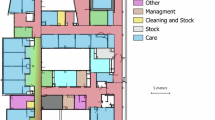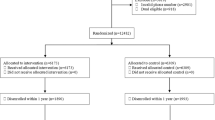Abstract
To better connect non-emergent 911 callers to appropriate care, Washington, DC, routed low-acuity callers to nurses. Nurses could provide non-emergent transportation to a health centre, recommend self-care or return callers to the traditional 911 system. Over about one year, 6,053 callers were randomized (1:1) to receive a business-as-usual response (ncontrol = 3,023) or further triage (ntreatment = 3,030). We report on seven of nine outcomes, which were pre-registered (https://osf.io/xderw). The proportion of calls resulting in an ambulance dispatch dropped from 97% to 56% (β = −1.216 (−1.324, −1.108), P < 0.001), and those resulting in an ambulance transport dropped from 73% to 45% (β = −3.376 (−3.615, −3.137), P < 0.001). Among those callers who were Medicaid beneficiaries, within 24 hours, the proportion of calls resulting in an emergency department visit for issues classified as non-emergent or primary care physician (PCP) treatable dropped from 29.5% to 25.1% (β = −0.230 (−0.391, −0.069), P < 0.001), and the proportion resulting in the caller visiting a PCP rose from 2.5% to 8.2% (β = 1.252 (0.889, 1.615), P < 0.001). Over the longer time span of six months, we failed to detect evidence of impacts on emergency department visits, PCP visits or Medicaid expenditures. From a safety perspective, 13 callers randomized to treatment were eventually diagnosed with a time-sensitive illness, all of whom were quickly triaged to an ambulance response. These short-term effects suggest that nurse-led triage of non-emergent calls can safely connect callers to more appropriate, timely care.
This is a preview of subscription content, access via your institution
Access options
Access Nature and 54 other Nature Portfolio journals
Get Nature+, our best-value online-access subscription
$32.99 / 30 days
cancel any time
Subscribe to this journal
Receive 12 digital issues and online access to articles
$119.00 per year
only $9.92 per issue
Buy this article
- Purchase on SpringerLink
- Instant access to full article PDF
Prices may be subject to local taxes which are calculated during checkout



Similar content being viewed by others
Data availability
The data analysed in this paper were provided by DC’s FEMS, Office of the Chief Technology Officer and DHCF and contain protected health information. To protect privacy, we cannot publicly post individual-level data. Qualified researchers and relevant approvals including ethical approval can request access to the de-identified data about this trial from the corresponding author. A formal contract will be signed, and an independent data protection agency should oversee the sharing process to ensure the safety of the data.
Code availability
All code used to produce this analysis is publicly available at https://github.com/thelabdc/FEMS-911NurseTriageLine-public.
Change history
27 June 2024
A Correction to this paper has been published: https://doi.org/10.1038/s41562-024-01921-9
References
9-1-1 Statistics (National Emergency Number Association, 2020).
Sporer, K. A. 911 patient redirection. Prehosp. Disaster Med. 32, 589–592 (2017).
Reducing Emergency Department Overuse: A $38 Billion Opportunity (New England Health Institute, 2011).
Bruijns, S. R. et al. Effect of introduction of nurse triage on waiting times in a South African emergency department. Emerg. Med. J. 25, 395–397 (2008).
Mills, J. et al. Effectiveness of nurse triage in the emergency department of an urban county hospital. J. Am. Coll. Emerg. Physicians 5, 877–882 (1976).
A Model for Better Community Healthcare: How One EMS System Achieved the Triple Aim from a Federal Health Care Innovation Award Grant (REMSA, 2017).
Gardett, I. et al. 911 emergency communication nurse triage reduces EMS patient costs and directs patients to high-satisfaction alternative point of care. Ann. Emerg. Dispatch Response 3, 8–13 (2015).
Møller, T. P. et al. Why and when citizens call for emergency help: an observational study of 211,193 medical emergency calls. Scand. J. Trauma Resusc. Emerg. Med. 23, 88 (2015).
Zinger, N. D., Blomberg, S. N., Lippert, F., Krafft, T. & Christensen, H. C. Impact of integrating out-of-hours services into Emergency Medical Services Copenhagen: a descriptive study of transformational years. Int. J. Emerg. Med. 15, 40 (2022).
Eastwood, K. et al. A novel approach for managing the growing demand for ambulance services by low-acuity patients. Aust. Health Rev. 40, 378–384 (2015).
District of Columbia Fire and Emergency Medical Services Integrated Healthcare Collaborative, Final Report (District of Columbia Fire & Emergency Medical Services, 2017).
Berchick, E. R. et al. Health Insurance Coverage in the United States: 2018 (US Department of Commerce, 2019).
DeLeire, T. in Health and Labor Markets (eds. Tatsiramos, K. & Polachek, S. W.) 155–194 (Emerald, 2019).
Finkelstein, A. N. et al. Effect of Medicaid coverage on ED use—further evidence from Oregon’s experiment. N. Engl. J. Med. 375, 1505–1507 (2016).
Lavetti, K. J. et al. How Do Low-Income Enrollees in the Affordable Care Act Marketplaces Respond to Cost-Sharing? Technical Report No. 26430 (National Bureau of Economic Research, 2019).
Taubman, S. L. et al. Medicaid increases emergency-department use: evidence from Oregon’s health insurance experiment. Science 343, 263–268 (2014).
Datta, S. & Mullainathan, S. Behavioral design: a new approach to development policy. Rev. Income Wealth 60, 7–35 (2014).
Rose, A. J. et al. Primary care visit regularity and patient outcomes: an observational study. J. Gen. Intern. Med. 34, 82–89 (2019).
Daniels, O. District triage line continues to trim non-emergency calls from 911. Washington Post 20 November (2023).
Python Language Reference, v.3.8.6 http://www.python.org (Python Software Foundation, 2020).
R: a language and environment for statistical computing https://www.R-project.org/ (R Foundation for Statistical Computing, 2021).
Briggs, J. K. Telephone Triage Protocols for Nurses (Wolters Kluwer Health, 2020).
Finkelstein, A. et al. Health care hotspotting—a randomized, controlled trial. N. Engl. J. Med. 382, 152–162 (2020).
Billings, J. et al. Emergency Room Use: The New York Story (Commonwealth Fund, 2000).
Acknowledgements
This work would not be possible without the support of M. Bowser (mayor), K. Donahue (city administrator), R. Young (former city administrator), S. Quinney (director of The Lab @ DC), G. M. Dean (retired fire chief), FEMS, the Office of Unified Communications, the DHCF, the FQHCs, the DC Primary Care Association, the Department of Health and the Office of the Deputy Mayor for Public Safety and Justice. We thank the following for their time and assistance in making this evaluation possible: M. Baisley, A. Beaton, V. Bishop, D. Braman, R. Breslin, S. Brown, I. Bucksell, J. Coombs, D. Corcoran, T. Curtis, O. Dedner, J. Doleac, N. Donnelly, J. Duff, T. Dutta, L. Edmonson, B. Egar, K. Gan, H. Gil, A. Grady, J. Greenberg, K. Holmes, E. Holve, A.-T. Huang, A. Huberts, T. Kavaleri, D. Kornfield, E. Koshkin, B. Kreiswirth, B. Krucoff, K. Liebowitz, M. MacCarthy, K. Minnich, A. Mauro, L. Nesbitt, C. Nguyen, C. Nwaete, P. Oandasan, K.Y. Oh, J. Reed, M. Reed, S. Roque, C. Scholsberg, N. Smith, D. Stanescu, P. Testa, T. Thangalvadi, W. Turnage, J. Wedeles, D. Weinroth, J. Weissfeld, O. Whittaker, M. Williamson, S. Willig and J. Wobbleton. We especially thank M. A. Bates, N. Choudhry and B. Özler for reviewing the pre-analysis plan and M. Welch for her substantive and project management contributions during the review process. The intervention as a whole was funded by general appropriations from the District of Columbia. R.P.H., as the medical director of DC FEMS, was also funded through DC appropriations. C.H., K.H.W., R.T.M. and D.Y. were funded through the Laura and John Arnold Foundation (now Arnold Ventures). R.A.J. was funded through the ABF/JPB Foundation Access to Justice Scholars programme for time supporting the work. The funders had no role in study design, data collection and analysis, decision to publish or preparation of the manuscript.
Author information
Authors and Affiliations
Contributions
Conceptualization: C.H., R.P.H., R.T.M., K.H.W. and D.Y. Methodology: C.H., R.T.M., K.H.W. and D.Y. Visualization: R.A.J. and K.H.W. Coding and analysis—original analysis: R.A.J. and K.H.W. Coding and analysis—review and supplemental: R.A.J., R.T.M. and K.H.W. Project administration: C.H. and R.P.H. Supervision: C.H. and R.T.M. Writing—original draft: C.H., R.A.J. and K.H.W. Writing—review and editing: C.H., R.P.H., R.A.J., R.T.M., K.H.W. and D.Y.
Corresponding author
Ethics declarations
Competing interests
R.P.H. was during the commission of this study the medical director of DC FEMS and draws a salary from the District of Columbia. The remaining authors declare no competing interests.
Peer review
Peer review information
Nature Human Behaviour thanks Stefan Morreel and Armann Ingolfsson for their contribution to the peer review of this work.
Additional information
Publisher’s note Springer Nature remains neutral with regard to jurisdictional claims in published maps and institutional affiliations.
Extended data
Extended Data Fig. 1 Overall counts of treated and control group callers aggregated to the monthly level.
The figure shows the raw counts of treatment and control group callers for each of the eleven months in the study period. We see a sharp rise after the triage line was expanded to 24 hours per day.
Extended Data Fig. 2 Balance plot: treatment and control group (Medicaid beneficiary sample).
The figure shows the standardized mean difference for each attribute between the treatment and control group, which helps us compare variables on different scales (for example, years versus percentages).
Extended Data Fig. 3 Detailed outcomes of the safety analysis.
The flow chart shows a low incidence of safety events.
Supplementary information
Supplementary Information
Four sections of supplementary discussion: safety analysis results, matching to Medicaid beneficiaries, departures from the pre-analysis plan and key sections of code.
Rights and permissions
About this article
Cite this article
Wilson, K.H., Johnson, R.A., Hatzimasoura, C. et al. A randomized controlled trial evaluating the effects of nurse-led triage of 911 calls. Nat Hum Behav 8, 1276–1284 (2024). https://doi.org/10.1038/s41562-024-01889-6
Received:
Accepted:
Published:
Issue date:
DOI: https://doi.org/10.1038/s41562-024-01889-6



